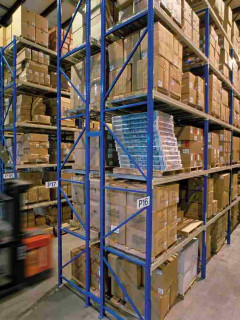33% : c’est le pourcentage de ventes en ligne qui se feraient sur les marketplaces à l’horizon 2021, selon une étude de Xerfi. De quoi encourager les commerçants, traditionnels ou possédant déjà une boutique en ligne, à se positionner sur ces places de marché.
Il faut dire que l’intérêt des marketplaces n’est plus à prouver. En vous y faisant une place de choix, vous augmentez la visibilité de vos produits sur le web, touchez de nouvelles cibles, et augmentez votre chiffre d’affaires.
Seulement, e-commerce et marketplace présentent des caractéristiques différentes, qu’il faut savoir prendre en compte pour viser une performance optimale. Découvrez dans cet article les conseils-clés pour lancer votre e-commerce sur une marketplace, des astuces digitales aux bonnes pratiques logistiques à envisager.

Bien choisir votre marketplace
Dans un premier temps, il s’agit pour vous de sélectionner la ou les marketplaces où vous
- Global marketplaces, such as Amazon, eBay, AliExpress or cDiscount, where all types of products are offered by sellers
- Sector-specific marketplaces (often linked to retailers’ e-commerce sites): FNAC for cultural, tech and audiovisual products, Darty for household appliances and HiFi, JouéClub for toys, La Redoute for furniture, etc
- Marketplaces on social networks: Facebook Marketplace is already well established, while Instagram Checkout is already available in the United States, and should soon arrive in Europe
your choice should therefore be based on the relevance of your products in relation to the current offer of these marketplaces. However, you should also take the time to find out about the charges and commissions set up by these platforms in order to make this choice. You should also take the time to observe which sales support tools are available to you on the marketplace you are considering: retail media advertising (to highlight your products), statistical data of varying degrees of development, etc
| The RAJA tip: If your e-commerce site already has a lot of product listings, and switching them to the marketplace of your choice seems like a daunting task, you should know that there are solutions for integrating the main marketplaces with your e-commerce site, which allow you to automatically switch these product listings from your site. This is particularly the case if you have an e-commerce site on WooCommerce (WordPress), with a plugin such as WP-Lister Lite for eBay |
defining your GTCs and your returns policy
It’s important to know: on a marketplace, even if the site is positioned “between” the end customer and the seller, the latter remains responsible for the management and sale of his products. This is why these platforms ask sellers to define their General Terms and Conditions of Sale (GTCs), as well as their returns policy. If you already have an e-commerce site that complies with the regulations, this step will be simple: all you need to do is toindicate in the marketplace settings your existingGTCs and returns policy. However, don’t be afraid to take advantage of this new project to review them both. To do so, consult our guide “Constructing your returns logistics: essential questions”.

| RAJA’s extra tip: Have you heard of returnable packaging? This is packaging that is specifically designed to be strong enough to protect goods during a return order. It makes returns easier for your customers, and therefore significantly improves the customer experience you offer them. |
choosing the products to put forward first on your shop
Once these two basic tips have been applied, it is time to select which of your products will enable you to launch your e-commerce on the marketplace of your choice. On this point, it is recommended that, in order to aim for optimum performance from the moment you launch, you avoid switching your entire catalogue to the chosen marketplace. It is better to start by integrating your flagship products, which can be..
- Products that are in high demand on the platform, for example because they are exclusive or rare
- Products that are already selling well on your e-commerce shop
by doing so, you are opting for an ROI approach. Your catalogue of flagship products, reduced at the time of your launch on the marketplace, will indicate to the marketplace’s algorithm that your shop is performing well, which will then give your products greater prominence in the search results.
Organising your stock for sales on the marketplace
You now have in mind the products to be integrated into the marketplace of your choice from your e-commerce site. As you might have guessed, it’s now time to organise your stock properly in relation to this strategy. Make sure you segment your stock properly between products dedicated to your e-commerce site, those dedicated to sales on the marketplace, and those dedicated to in-store sales (if you also have a physical shop). In terms of organising your e-commerce warehouse, this means that..
- Label your products, racks and shelves in the warehouse: the idea is to delimit the products dedicated to each channel, to facilitate the picking of your operators and avoid stock management errors.
- Set upa stock management system that suits your business: to do this, you can consult our guide “Organising a storage warehouse: the main principles”.
in any case, it is crucial to keep your stock up to date, as product availability is one of the criteria taken into account by the marketplaces’ algorithms to enhance the visibility of your shop on the platforms.
Doing a good job on your product sheets
When launching on a marketplace, as in e-commerce on a shop that belongs to you, it is impossible to miss out on impeccable product sheets. This is another key criterion to ensure that the algorithms highlight your products on the platforms, and also to provide your customers with as much information as possible, and to motivate them to place an order. Here are a few key tips to ensure that your product sheets are done with the utmost care
- Fill in all the details about your product: dimensions, price, quantity, etc. The more precise your files are, the more you will help consumers to plan their purchase.
- Describe your product by including keywords that your potential customers are looking for on the platform. To do this, you can take inspiration from your competitors, or from the expressions that are proposed in the search bar of the marketplace in question.
- Include attractive and realistic images in your product sheets. These photos should give a clear representation of the product. Also remember to adapt them to the mobile format: users of marketplaces are increasingly using their smartphones and tablets to shop online.

Investing in advertising to launch your e-commerce on a marketplace
You have already understood from the other tips above: the algorithms of the marketplaces use several criteria to highlight products in the search results. Generally speaking, they will use criteria such as the name of the product, the name of the company, the name of the company, the name of the company, the name of the company, the name of the company, the name of the company, the name of the company, the name of the company, the name of the company, the name of the company, the name of the company, etc
- Product availability
- The quality and detail of the product sheets
- Customer reviews
- Speed of sales..
cependant, lorsqu’on lance son e-commerce sur une marketplace, faire ses premières ventes ou générer ses premiers avis clients peut être complexe. Pour pallier ce souci, il est possible d’investir dans la publicité (dite “retail media”) pour mettre en avant vos produits-phares.
En investissant un peu de votre budget dans la publicité sur ces plateformes, vous donnez un petit coup de pouce à vos produits, qui se vendront mieux, et viendront ainsi booster les algorithmes de référencement sur la marketplace.
Pour vous lancer dans le retail media, commencez donc par investir un petit budget dans la promotion de vos produits. N’hésitez pas à fonctionner en test and learn, c’est-à-dire à commencer avec un petit budget, à tester sur une catégorie de vos produits-phares, pour repérer les bonnes pratiques, et accroître votre ROI au fur et à mesure
.
Susciter les avis clients
C’est un fait : les avis clients constituent une
véritable “
preuve sociale”, qui vient stimuler l’acte d
- Eco-responsible packagingyou can also use postal packaging to show your commitment to environmental protection, which is becoming increasingly popular with consumers
- Customised packaging, to make you stand out from the other sellers on the marketplace, and to highlight your brand upon delivery?
- Variable height packagingthe use of the “green” packaging, which limits the amount of empty space in parcels?
- Returnable packaging, to make it easier for your customers to return their orders?
remember also to take care of theunboxing of your products. A small personalised message, a sample to test, a nice cushioning material… Everything in your packages must be thought of to create the famous “wow effect” that will anchor your shop in the minds of your customers.
Manage your deliveries successfully
If you already run an e-commerce shop, you know it well: customers expect e-tailers and sellers on marketplaces to offer fast and flexible deliveries. This is a real differentiating factor for your business on marketplaces. So how can you manage your deliveries brilliantly?
- Be responsive to orders: update the status of the parcel as soon as possible to prove your responsiveness and avoid messages from after-sales services inquiring about the status of the delivery.
- Offer different types of delivery: express, international, point-relais… The more choice your potential customers have, the more likely they are to order from your shop.
- Have certain small deliveries delivered directly to the letterbox, using postal packaging. Your customers will be delighted to be able to get their parcels as soon as the carrier passes by, and without any contact!
thanks to these best practices, you are now ready to offer an attractive product catalogue on a marketplace, and manage all the logistics related to selling on a marketplace like a pro!















